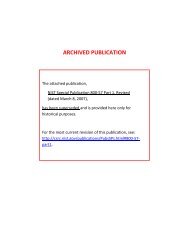NISTIR 7298 Revision 1, Glossary of Key Information Security Terms
NISTIR 7298 Revision 1, Glossary of Key Information Security Terms
NISTIR 7298 Revision 1, Glossary of Key Information Security Terms
You also want an ePaper? Increase the reach of your titles
YUMPU automatically turns print PDFs into web optimized ePapers that Google loves.
NIST IR <strong>7298</strong> <strong>Revision</strong> 1, <strong>Glossary</strong> <strong>of</strong> <strong>Key</strong> <strong>Information</strong> <strong>Security</strong> <strong>Terms</strong><br />
A device or program that controls the flow <strong>of</strong> network traffic between<br />
networks or hosts that employ differing security postures.<br />
SOURCE: SP 800-41<br />
Firewall Control Proxy – The component that controls a firewall’s handling <strong>of</strong> a call. The<br />
firewall control proxy can instruct the firewall to open specific ports<br />
that are needed by a call, and direct the firewall to close these ports at<br />
call termination.<br />
SOURCE: SP 800-58<br />
Firmware – The programs and data components <strong>of</strong> a cryptographic module that<br />
are stored in hardware within the cryptographic boundary and cannot<br />
be dynamically written or modified during execution.<br />
SOURCE: FIPS 140-2<br />
Computer programs and data stored in hardware - typically in readonly<br />
memory (ROM) or programmable read-only memory (PROM) -<br />
such that the programs and data cannot be dynamically written or<br />
modified during execution <strong>of</strong> the programs.<br />
SOURCE: CNSSI-4009<br />
FISMA – See Federal <strong>Information</strong> <strong>Security</strong> Management Act.<br />
Fixed COMSEC Facility – COMSEC facility located in an immobile structure or aboard a ship.<br />
SOURCE: CNSSI-4009<br />
Flaw – Error <strong>of</strong> commission, omission, or oversight in an information system<br />
that may allow protection mechanisms to be bypassed.<br />
SOURCE: CNSSI-4009<br />
Flaw Hypothesis Methodology – System analysis and penetration technique in which the specification<br />
and documentation for an information system are analyzed to<br />
produce a list <strong>of</strong> hypothetical flaws. This list is prioritized on the<br />
basis <strong>of</strong> the estimated probability that a flaw exists, on the ease <strong>of</strong><br />
exploiting it, and on the extent <strong>of</strong> control or compromise it would<br />
provide. The prioritized list is used to perform penetration testing <strong>of</strong><br />
a system.<br />
SOURCE: CNSSI-4009<br />
Flooding – An attack that attempts to cause a failure in a system by providing<br />
more input than the system can process properly.<br />
SOURCE: CNSSI-4009<br />
Pg 78

















